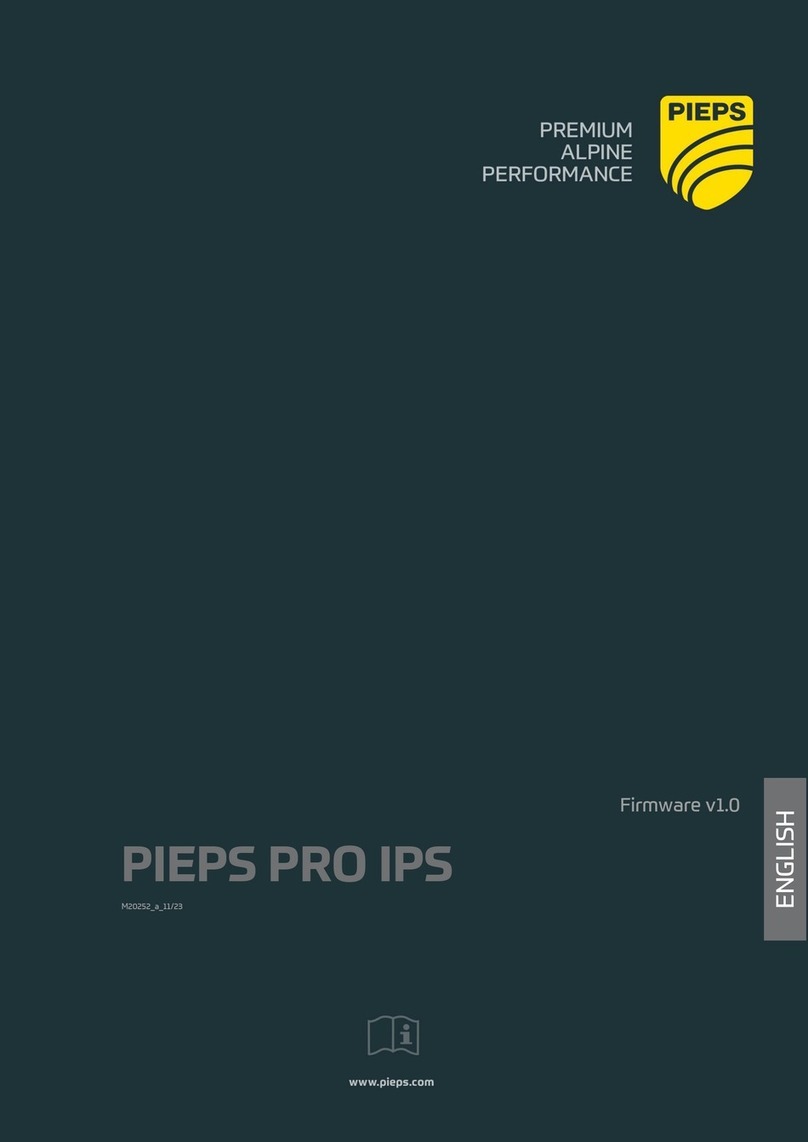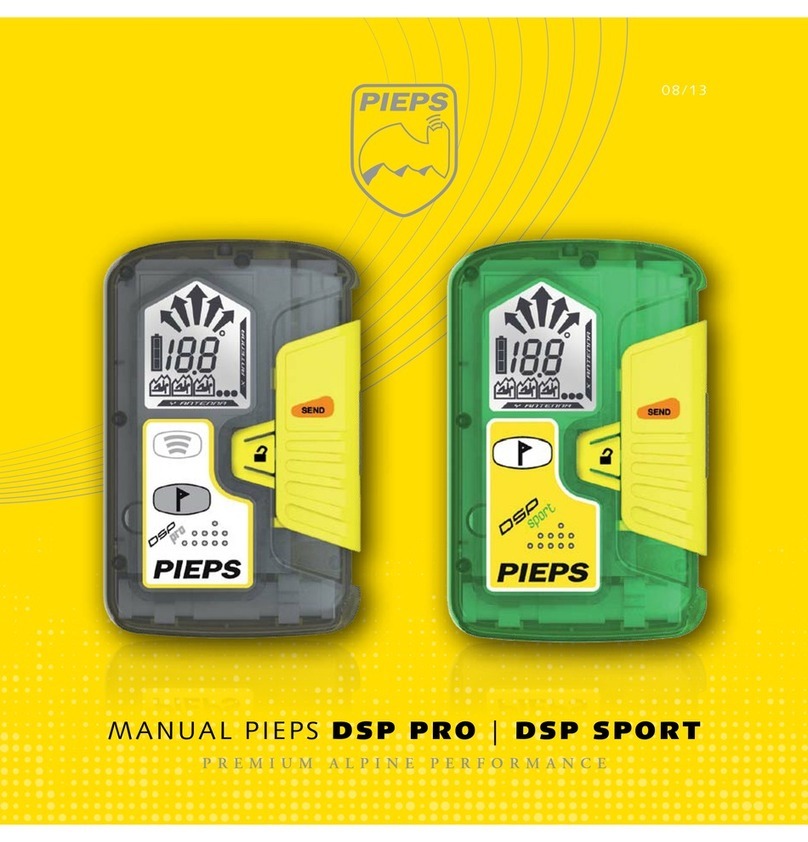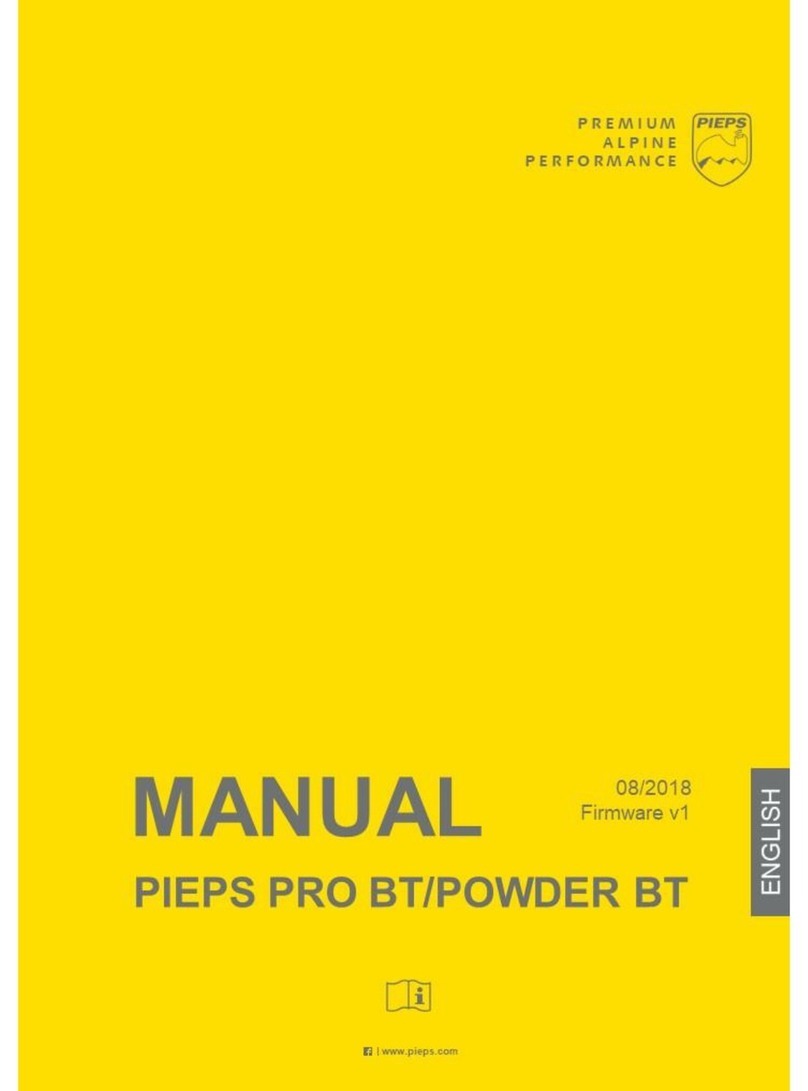
TECHNICAL DATA
Warranty Conditions: The device is guaranteed by the manufacturer against defects in material
and workmanship for a period of 2 years from the date of purchase. • This warranty does not apply
to damage caused by incorrect use, dropping or dismantling of the device by unauthorized persons.
• Any further warranty or liability for consequential damage is expressly excluded. • Warranty claims
should be addressed - enclosing the receipt of purchase - to the relevant sales outlet.
PIEPS warranty extension free of charge: Extend the warranty of
your PIEPS DSP/DSP Tour from 2 to 5 years: With the PIEPS warranty
extension you have the possibility to extend the standard warranty of your PIEPS
DSP/DSP Tour free of charge. Simply register online at www.pieps.com and get
your warranty certicate for 5 years valid from the date of purchase. You can save
on repair costs and valuable time. The warranty can be extended within 3 months
from the date of purchase.
Device designation PIEPS DSP |PIEPS DSP TOUR
Transmission frequency 457 kHz (EN 300718)
Power supply 3 batteries, Alkaline (AAA), IEC-LR03, 1.5V
Battery lifetime min. 200 h SEND-mode
Maximum range
DSP: 60 meters / DSP Tour: 50 meters
Search strip width 50 meters
Earphone socket Stereo earphone 3.5 mm, min. 32 Ohm
Temperature range -20°C to +45°C
Weight 198 g (incl. batteries)
Dimensions (LxWxH) 116 x 75 x 27 mm
WARNING CODES
Warning-
code
Warning description Warning correction
No indication on display Check batteries (polarity and voltage) and
replace if required.
If there is no indication again, bring your be-
acon to an authorized service center.
E 04 Transmission eld strength too low:
Transmitter detuning due to iron,
interference due to other electronic
equipment, breaking of an antenna
Repeat the process in an interference free
area (outdoor). If the warning code is indi-
cated again, bring your beacon to an author-
ized service center.
E 21 Software error Bring your beacon to an authorized service
center.
E 22
Receiving strength of antennas too
low: Antennas detuning due to iron,
interference due to other electronic
equipment, other beacons in the
immediate environment (< 3m)
Repeat the process in an interference free
area (outdoor). If the warning code is indi-
cated again, bring your beacon to an autho-
rized service center.
E 23 Receiver amplication too low:
Interference due to other electronic
equipment, other beacons in the
immediate environment (< 3m)
Repeat the process in an interference free
area (outdoor). If the warning code is indi-
cated again, bring your beacon to an autho-
rized service center.
E 25 Transmission frequency outside the
permissible range: other beacons in
the immediate environment (< 3m)
transmit with a frequency outside the
standard, interference due to other
electronic equipment
Repeat the process in an interference free
area (outdoor). If the warning code is indi-
cated again, bring your beacon to an autho-
rized service center.
E 27 Processor error Switch off your beacon, wait for 5 seconds,
and switch it on again. If the warning code
is indicated again, bring your beacon to an
authorized service center.
EN DEESFRITCZSK
Certication: Warning: Any changes or modications not expressly approved by the manufacturer, responsible for compliance, could
void the user’s authority to operate this device. Europe: Manufacturer: PIEPS GmbH Country of manufacture: Austria Device type: PIEPS
DSP; The device conforms to the Standard ETS 300718 WEEE 2002/96/EC Canada: IC: 4710A-DSP01 USA: FCC ID: REMDSP01 This
device conforms to Paragraph 15 of the FCC regulations. Operation is subject to the following two conditions: 1) This device may not cause
harmful interference, and 2) this device must accept any interference received, including interference that may cause undesired operation.
Conformity: PIEPS GmbH declares hereby, that the product PIEPS DSP fulls all requirements and regulations of directive 1999/5/
EC! The declaration of conformity can be downloaded at the following source: http://www.pieps.com/certication_pieps_dsp.pdf
Manufacturer
,
Sales
&
Service:
PIEPS GmbH, Parkring 4, 8403 Lebring, Austria, of[email protected], www.pieps.comRU
06/12 ||
06/12 3332






























